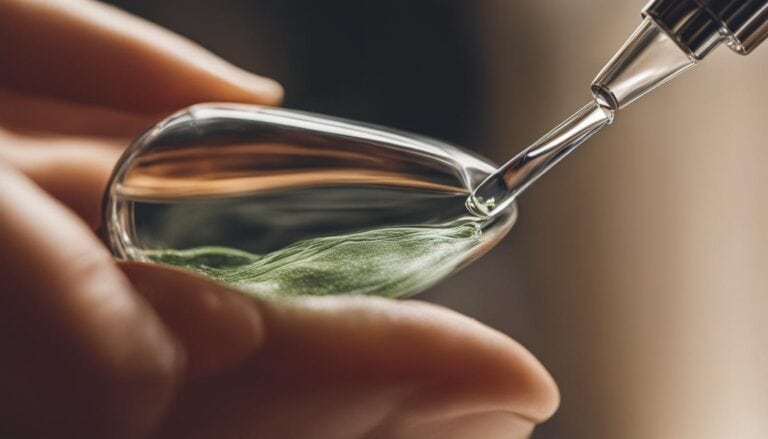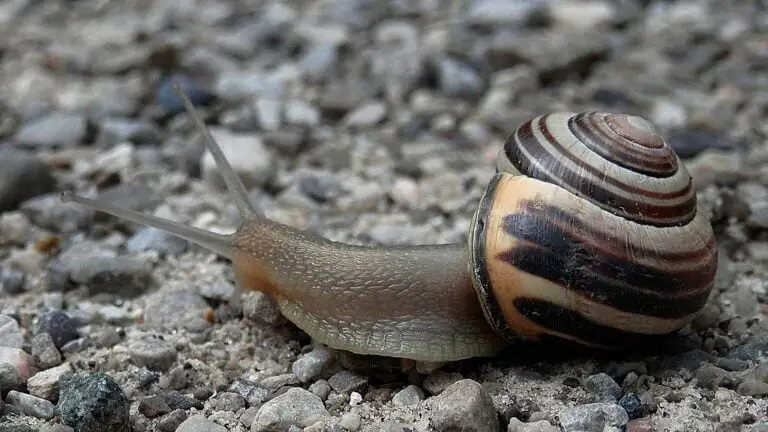Myths and Misconceptions About Snail Mucin in Skincare

As you navigate the sea of skincare ingredients, you might encounter myths about snail mucin that can obscure the substance’s true benefits. As an element that has traversed history from ancient Greece to the modern-day pedestals of Korean beauty, snail mucin remains one of the most misunderstood skincare ingredients. Despite skepticism, certain truths about snail mucin can’t be denied. It possesses a unique composition, filled with hyaluronic acid, glycoprotein enzymes, and peptides, celebrated for its remarkable hydrating capabilities. To truly understand what sets snail mucin apart, one must sift through the myths and recognize the facts vs. fiction.
Dermatologist Tabasum Mir has shed light on this cosmetic puzzle, debunking snail mucin myths and confirming that while some ingredients are not exclusive to snail secretion, its unique blend still stands out in skincare. Let’s delve into the snail mucin truths and dismantle the myths that shroud this natural wonder.
The Surprising History of Snail Mucin in Skincare
Unveil the veil of time and you will discover the storied past of snail mucin, an ingredient that has triumphed through the centuries from the hands of ancient Greek physicians to the forefront of Korean beauty vaults. Behind the veil of modern buzzwords and snail mucin skincare myths, lies a treatment that dates back to antiquity, revealing its longstanding tradition in skin health and rejuvenation.
Understanding snail mucin is akin to embarking on a historic journey where its unique properties were once medicines for illustrious empires. Passed down through generations, these snail mucin ingredient facts resurface in today’s skincare conversations, debunking snail mucin skin care misconceptions with empirical endorsements from certified dermatologists.
From Ancient Greece to Korean Beauty Trends
As a testament to the snail mucin’s enduring legacy, it’s fascinating to note that this nature-derived elixir found relevance across oceans and eras. Snail mucin made its initial foray into the realm of skincare in Ancient Greece, where it was revered for its healing properties. Fast-forwarding to the present day, it continues to bask in the spotlight within the sophisticated realm of Korean-based beauty formulas, a resurgence driven by innovation and a commitment to hydration.
Snail Mucin’s Comeback in Modern Cosmetics
Its modern-day revival can be credited to a blend of historical wisdom and state-of-the-art cosmetic science. As you sift through snail essence face masks in your local beauty store or online boutique, the annotations from skincare experts such as dermatologists echo the potency of snail mucin as an efficacious hydrating agent. Through the clarity provided by these professionals, one can maneuver past the common myths and discover the authentic virtues of this storied skincare substance.
For a more detailed exploration of snail mucin’s journey from ancient Greece to Korean beauty trends, check out our comprehensive guide.
Myths About Snail Mucin: Separating Fact from Fiction
When it comes to snail mucin, the beauty world is abuzz with talk, but how much of it is shrouded in common misconceptions and snail mucin misinformation? Touted for its moisture-rich properties and historical pedigree in skincare regimes, it’s crucial to separate the myths from the facts to truly understand the value of snail mucin in your skincare lineup.
Many raise eyebrows, questioning if accelerating hydration and collagen production are merely lofty promises or if there is substance to the claims. Let’s address the myths head-on and provide clarity, clarifying snail mucin benefits with evidence that underscores its acknowledged role in beauty and dermatological circles.
Dermatologist Tabasum Mir, speaking with HuffPost, highlighted that the crucial elements in snail mucin are, in fact, found in numerous other beauty products. However, the distinction lies in snail mucin’s complete package – a combination that delivers unparalleled hydrating benefits.
Indeed, when we peel back the layers of speculation, what remains is the unvarnished truth – snail mucin is a multifaceted player in the skincare game. Its recognition by experts only reaffirms its standing amidst a myriad of evolving beauty trends.
| Fact | Fiction |
|---|---|
| Snail mucin has been historically used for skin treatment dating back to Ancient Greece. | Snail mucin’s benefits in skincare are a modern discovery. |
| Dermatologists acknowledge snail mucin for its hydration and potential anti-aging properties. | Only anecdotal evidence supports the use of snail mucin in skincare. |
| Snail mucin consists of hyaluronic acid, glycoprotein enzymes, and peptides, which are beneficial for the skin. | Snail mucin contains exclusive ingredients not found anywhere else. |
| Snail mucin is suitable for use on all skin types and is well-tolerated by most. | Snail mucin is likely to cause skin irritation or allergic reactions in many users. |
As you navigate your journey through the world of skincare, keep these clarifications in mind. By dispelling the myths and embracing the facts, you can make informed choices in adding snail mucin to your beauty routine, ensuring that you’re not swayed by the prevailing winds of misinformation.
What Dermatologists Really Say About Snail Mucin
In the depth of the snail mucin facts vs. fiction debate, a cluster of truths emerge under the scrutiny of skincare professionals. Breaking through the shell of snail mucin myths, credible voices in dermatology share insights into the benefits and precautions of this intriguing ingredient.

Understanding Snail Mucin’s Skin Benefits
Embracing the snail mucin reality in skincare involves acknowledging its proven efficacy. Sheel Desai-Solomon, MD, and Ted Lain, MD, both board-certified dermatologists, salute snail mucin for its hydration prowess and ability to stimulate the skin’s own collagen production, thereby playing a role in its healing and regeneration. This naturally derived ingredient consists of a rich blend of growth factors and vital nutrients such as zinc, manganese, copper peptides, and vitamins A and E, which have been shown to significantly improve skin hydration, soothe irritation, and encourage cell regeneration.
Criticisms and Endorsements from Skincare Professionals
While endorsements of snail mucin’s efficacy in the realm of hydration and collagen stimulation are prevailing, dermatologists also note potential concerns. Specifically, those with existing health conditions or on prescribed treatments are advised to consult their healthcare provider before incorporating snail mucin into their skincare routine due to the risk of allergic reactions. This duality of snail mucin’s capable promise and the need for cautionary tales epitomizes the snail mucin truths within the cosmetic industry.
Dermatologists direct a beam of spotlight onto snail mucin’s role in the cosmeceutical narrative, and they carefully balance its endorsements with inferential critiques. This sniper precision serves consumers seeking to scratch beneath the surface and discern the true scope of snail mucin’s abilities amidst the torrent of beauty breakthrough claims.
Is Snail Secretion Filtrate Unique in Hydration?
In the quest to uncover the truths behind snail mucin hydration, we face a conundrum. The ingredient, lauded for its hydrating effects, is shrouded in a number of snail secretion filtrate myths. These misconceptions can make it challenging for consumers to understand the real benefits of snail mucin in their skincare routine. As you seek clarity, let’s delve into a fact-based analysis to dispel the common snail mucin false beliefs.
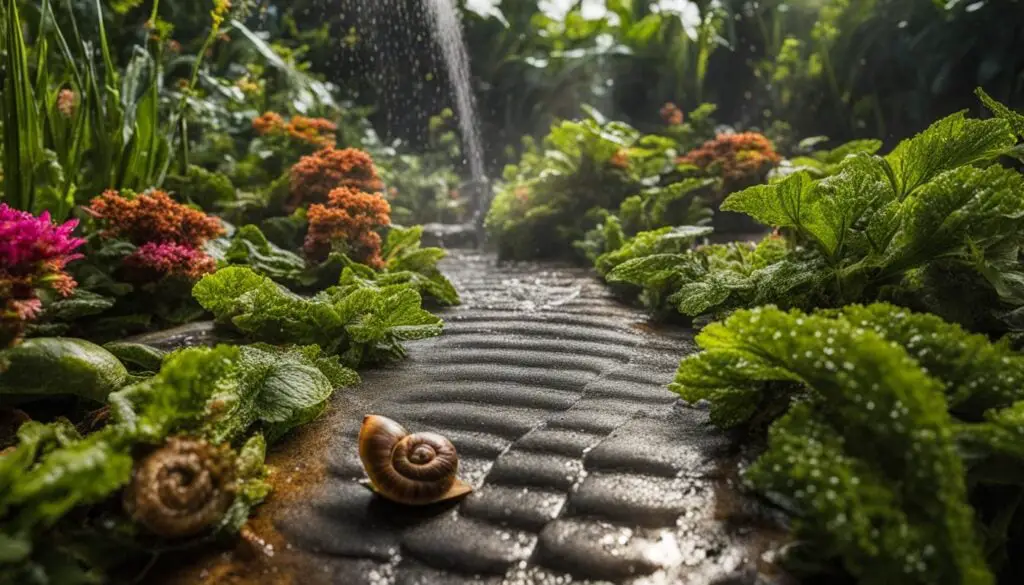
Breaking Down the Hydrating Properties of Snail Mucin
At its essence, snail mucin is a complex mix of proteins, glycolic acids, and elastin that come together to create a powerful hydrating solution. When applied to the skin, this natural secretion has been known to provide a barrier which locks in moisture and enhances the skin’s own barrier against environmental stressors.
Dermatologist Tabasum Mir has highlighted the fact that while the hyaluronic acid in snail mucin is indeed a powerful hydrating agent, similar compounds can also be found in a variety of other skincare products. Thus, while snail mucin is effective, it’s the synergy of its constituents that makes it uniquely beneficial for maintaining skin moisture.
Comparing Snail Mucin with Other Hydrating Agents
| Ingredient | Snail Mucin | Other Hydrating Agents |
|---|---|---|
| Hyaluronic Acid | Present | Widely used in skincare |
| Growth Factors | Naturally occurring | Less common, usually synthetic |
| Antimicrobial Properties | Inherent | Not always present |
| Collagen Stimulation | Boosts collagen production | May require combination with other ingredients |
| Glycoprotein Enzymes | Key component | Found in some advanced formulas |
| Peptides | Abundant | Commonly included |
While other hydrating agents available on the market can mimic the effects of snail mucin to a degree, the unique combination and balance of ingredients in snail mucin provide a distinct advantage. It’s this proprietary blend that bolsters skin hydration beyond what many single-ingredient products can offer, reinforcing the value snail mucin holds in skincare regimes.
Common Misconceptions about Snail Mucin in Skincare
Amidst the groundswell of interest surrounding natural ingredients, snail mucin has emerged as a topic of both fascination and speculation. Confronting the snail mucin myths, it’s crucial for you to navigate the facts, leaving behind the trails of snail mucin skin care misconceptions. Before incorporating this intriguing ingredient into your regimen, let’s clarify what’s fiction and what’s an undeniable hydration powerhouse.

At the heart of the skepticism lies the belief that snail mucin offers a roster of unparalleled benefits. The truth, however, is not so one-dimensional. While snail mucin does indeed hydrate, similar effects can be achieved using other well-known skincare constituents. Nonetheless, its combination of moisture-locking and skin-regenerative attributes denotes a valuable contribution to your skincare lineup.
“One doesn’t need to chase after exotic ingredients when the commonly found hyaluronic acid and peptides serve well. Yet, snail mucin holds its ground with a complete formula for skin revival,” acknowledges a panel of experts.
An analysis of prevailing snail mucin myths versus the documented properties delivers clear insights:
| Myth | Reality |
|---|---|
| Snail mucin contains magical elements unique to its composition. | Many of snail mucin’s ingredients, such as hyaluronic acid and peptides, are found in other skincare products. |
| Snail mucin is the best and only source of hydration for skin. | Snail mucin excels in hydration but is one of many effective moisturizing options available. |
| Use of snail mucin guarantees the reversal of skin aging. | Though it aids in skin regeneration, snail mucin is not a standalone cure for aging. |
| All positive claims of snail mucin are purely anecdotal. | Scientific studies and dermatological endorsements confirm its skin benefits. |
Your skincare choices should be anchored in evidence, transcending trends and myths. By understanding the real capabilities of snail mucin, you are empowered to utilize it as an informed and discerning advocate for your skin’s health.
The Truth Behind Snail Mucin and Aging Prevention
The topic of anti-aging has consistently enthralled those in pursuit of ever-youthful skin. Amidst the array of age-defying ingredients, the emergence of snail mucin has captured the curious eye of the beauty industry. But you might wonder, can an ingredient used since ancient times really pioneer modern-day aging prevention? Let’s unravel some anti-aging snail mucin truths, and expose the relationship between snail mucin and wrinkles, and how it relates to the body’s own collagen supply.
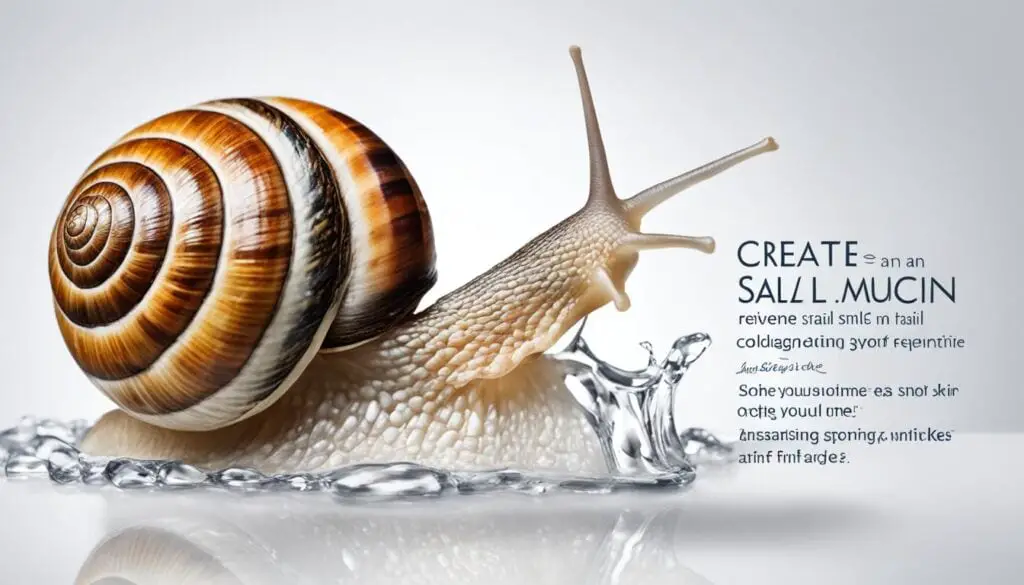
Can Snail Mucin Really Reduce Wrinkles?
Could this natural secretion be the panacea for age-related skin concerns? It’s touted that snail mucin, particularly when the snail is stressed, boasts a cocktail of growth factors that directly tap into our skin’s ability to look youthful by diminishing the presence of wrinkles. Consider the dermatological stamp of approval it’s received: snail mucin and collagen production are closely linked due to the ingredient’s glycolic acid, which can amplify the skin’s regenerative processes.
Examining the Effects of Snail Mucin on Collagen Production
Collagen, the skin’s structural backbone, depletes over time, leading to the sagging and creasing that translate into visible aging. Snail mucin is not just a barrier; it’s an enabler of your skin’s collagen synthesis. The growth factors in snail secretion are champions at kindling new skin cell growth and beckoning more collagen into being—potentially gifting skin with its famed bounce and resilience.
| Benefit | Snail Mucin | Traditional Anti-Aging Ingredients |
|---|---|---|
| Hydration | Rich in hyaluronic acid, locking in moisture | Often requires additional moisturizers |
| Collagen Stimulation | Contains growth factors to support collagen production | Typically include ingredients like retinol that indirectly support collagen |
| Wrinkle Reduction | Glycolic acid and peptides can potentially smooth fine lines | May offer temporary filling of wrinkles without treating underlying cause |
| Healing Properties | Facilitates skin regeneration and healing | Healing properties vary widely across ingredients |
While high hopes surround the snail mucin narrative, your skin’s response to skincare is as unique as your fingerprint. Remember, the most radiant canvas is achieved through a blend of knowledge, realistic expectations, and products that harmonize with your skin’s specific symphony of needs.
Debunking Snail Mucin Myths Regarding Acne Treatment
Snail mucin has been the subject of much discussion within the beauty and skincare community, particularly when it comes to acne treatment. But with myths and misconceptions rife, it’s essential to shed light on the real effects of snail mucin on acne-prone skin.
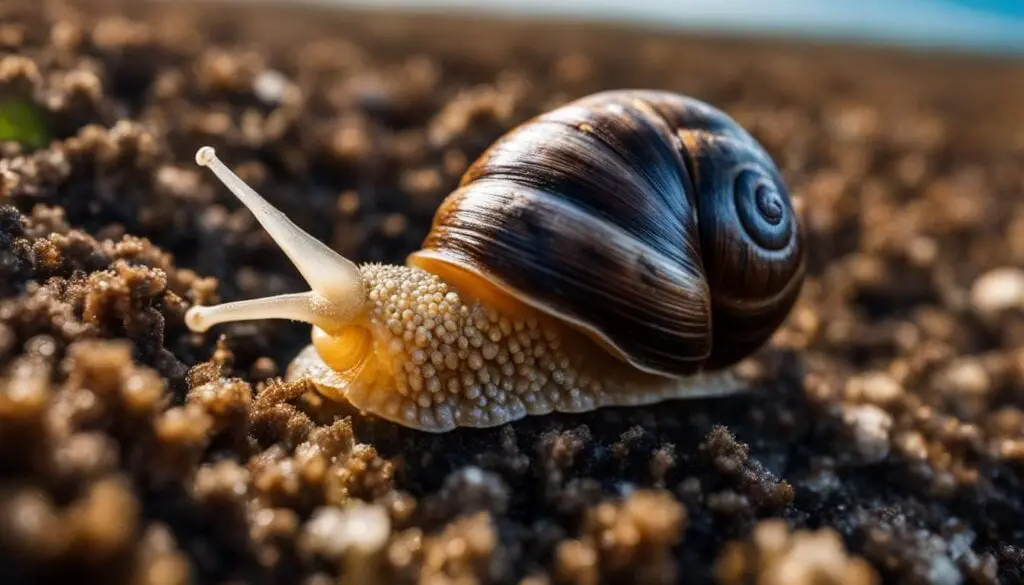
Snail Mucin’s Antimicrobial and Protective Qualities
Contrary to some beliefs, snail mucin harbors antimicrobial properties that could play a beneficial role in acne management. Studies point to its potential in targeting the bacteria primarily responsible for acne vulgaris. The protective qualities of snail mucin also contribute to its appeal, forming a barrier that may help shield the skin from harmful pathogens.
Addressing Myths Around Snail Mucin and Pore Clogging
Another common concern is whether snail mucin leads to pore-clogging, a critical consideration for anyone battling acne. However, according to Dr. Desai-Solomon and ongoing research, there’s no documented evidence to suggest that snail mucin clogs pores. In fact, the opposite might be true, with snail mucin showing promise in supporting the prevention of acne, thanks to its skin-nourishing and microbial balance-promoting characteristics.
| Myth | Reality |
|---|---|
| Snail mucin exacerbates acne. | Emerging research suggests snail mucin has properties that could help manage acne-causing bacteria. |
| Snail mucin clogs pores and causes breakouts. | Dermatologists have not found snail mucin to be pore-clogging, indicating that it’s unlikely to cause acne. |
| People with acne-prone skin should avoid snail mucin. | Snail mucin can be a part of acne treatment due to its beneficial properties unless one is allergic to the ingredient. |
Understanding the effects of snail mucin and acne is crucial if you’re considering incorporating this ingredient into your skincare routine. While further studies are warranted to fully ascertain snail mucin’s role in acne treatment, the current evidence and dermatological input lean towards snail mucin being a skin ally rather than a foe, debunking the myths that have long clouded its true potential in the skincare world.
Understanding Snail Mucin’s Role in Skin Healing and Regeneration
Snail mucin has come to the forefront of skincare discussions, being recognized for its powerful influence on skin healing. If you’re seeking to harness the restorative power of this ingredient, it’s essential to gauge its effectiveness in promoting skin’s recovery and vitality.
Collagen Stimulation and Cell Regeneration with Snail Mucin
At the heart of snail mucin’s remarkable skin healing capabilities are its collagen-stimulating properties. Collagen is critical for skin’s elasticity and firmness, and the growth factors in snail mucin are known to encourage natural collagen production. This can lead to enhanced skin cell regeneration, helping to repair damage and renew skin tissue.
The Effectiveness of Snail Mucin in Skin Repair
Aside from promoting cell growth, snail mucin is also lauded for its concentrated healing elements that aid in overall skin repair. By merging hydration with rejuvenating effects, snail mucin can be particularly effective for addressing issues of damaged or maturing skin.
When delving into the specifics of snail mucin skin repair, it is crucial to appreciate the various components at work. Antioxidants fight free radical damage, peptides support the structural integrity, and enzymes accelerate recovery processes. All these contribute to a noticeable improvement in the skin’s condition, especially when recovering from environmental stresses or injuries.
Acknowledging the role of snail mucin in skin health and rejuvenation, especially for those targeting certain skin conditions, will allow you to integrate this ingredient into your skincare regimen effectively. Whether you’re looking to enhance your natural healing processes or seeking an ally in the fight against signs of aging, snail mucin’s versatile profile stands out as a tried and true solution in skin therapy.
With its robust profile of skin-benefitting compounds, snail mucin continues to be as intriguing as it is effective. Its natural origin coupled with scientific endorsements of snail mucin skin healing and snail mucin cell regeneration affirm its position as a skincare powerhouse, one that is poised to remain a staple in the evolving landscape of beauty and wellness.
Misconceptions About Snail Mucin Production and Ethical Concerns
As the popularity of snail mucin in skincare continues to climb, the conversation around ethical concerns has become more prevalent. You might have heard the term ‘cruelty-free’ associated with your favorite products, but when it comes to snail mucin, there’s a grey area that warrants discussion. The heart of the matter lies in the production methods, specifically how the mucin is harvested from snails. As such, it’s vital to understand what goes into the extraction of this sought-after ingredient and why some practices are stirring ethical debates.
It’s a common belief that the more stressed a snail is, the better the quality of mucin produced. This has led to collection practices where snails are provoked to facilitate secretion. Questions arise, such as “Is this process harmful to the snails?” and “Do these practices align with the cruelty-free ethos?” These queries suggest a deeper look into the snail mucin production misconceptions that may influence your skincare choices.
| Production Method | Description | Ethical Concerns |
|---|---|---|
| Stress-Induced Secretion | Using physical agitation or salt solutions to provoke mucin release. | Potential distress and long-term health effects on snails. |
| Natural Secretion Collection | Mucin is collected without deliberately provoking the snails, mimicking their natural movements. | Lower, as snails are not subjected to intentional stressors. |
| Snail Farming | Snails are bred and kept in controlled environments for mucin extraction. | Depends on farming conditions, handling, and mucin collection methods. |
Given the distinction between methods, it’s clear that misgivings about snail mucin ethical concerns are not unfounded. However, not all snail mucin is created equal, and many skincare brands are now embracing more humane ways to harvest it. This dent in perceived misinformation emphasizes the importance of consumer education and transparency in skincare production.
When shopping for snail mucin products, you have the power to choose brands that prioritize ethical practices. Inquire about their harvesting methods and opt for those who are open about their cruelty-free processes. This way, your skincare routine doesn’t come at the cost of ethical compromise.
Unraveling the myths surrounding snail mucin production misconceptions can ensure that your beauty consumption is both conscious and informed. As we trail further into the realm of ethical skincare, the clarity you possess now can shed light on how your skin—and conscience—can best benefit from snail mucin.
Snail Mucin Misinformation: Is All Snail Mucin Sourced Equally?
Snail mucin has soared in popularity as a premium skincare ingredient, with many touting its hydrating and rejuvenating effects. But beneath the glossy surface of product packaging lies a pressing question: is all snail mucin sourced equally? In understanding the behind-the-scenes processes, you become more equipped to choose products that align with both quality and ethical standards.
How Snail Mucin Collection Methods Differ
The techniques used in snail mucin sourcing can range from non-invasive to more intrusive methods. Gentle extraction processes take a subtler approach, allowing snails to move freely in an environment where their mucin can be collected naturally, without causing undue stress. Alternatively, more aggressive methods involve provoking snails to release mucin through physical agitation or exposure to salt solutions, which can stress the creatures and raise ethical concerns among consumers.
The Impact of Collection Methods on Snail Mucin Quality
It’s not just the ethical considerations that vary with snail mucin collection methods; these practices can also influence the mucin’s properties and quality. Humane collection methods that prevent harm and stress to the snails tend to yield mucin that is not only of a higher quality but is also more consistent in its beneficial composition for skincare products.
The notion that stressed snails produce superior mucin has been largely debunked, and as such, ethical sourcing is increasingly becoming a hallmark of premium snail-based cosmetics. Brands that prioritize gentle snail mucin collection methods are often celebrated not just for their cruelty-free stance but also for the exceptional quality of their ingredients.
| Collection Method | Quality of Snail Mucin | Ethical Consideration |
|---|---|---|
| Gentle Extraction | Higher quality, consistent | Highest ethical standards |
| Physical Agitation | Variable quality | Risks snail welfare |
| Salt Solution Stress | Variable, potentially compromised quality | Questionable ethics |
As you explore the snail mucin market, it’s crucial to consider both the source of the mucin and the methods by which it was harvested. Products that underscore humane snail mucin sourcing practices often provide a superior level of snail mucin quality, contributing not only to the efficacy of the skincare item but also to the peace of mind that comes with making ethical purchases.
Clarifying Snail Mucin Benefits Beyond Hydration
While hydration might be the hallmark of snail mucin’s reputation in skincare, it’s vital to explore the depth of its potential. This natural elixir is not a one-trick pony; it holds a plethora of other skin-nourishing secrets. Filled with a cornucopia of vitamins and minerals alongside anti-inflammatory and healing components, snail mucin boldly steps beyond the boundaries of a mere hydrating agent.
The Vitamins and Minerals in Snail Mucin
Delve into the nutritive composition of snail mucin and you’ll find it’s rich in **vitamins and minerals** that are essential for skin health. Zinc and manganese play a pivotal role in skin repair and defense against environmental aggressors. Copper peptides, commonly revered in the skincare world for their collagen-boosting abilities, are also found naturally within snail mucin.
Moreover, vitamins A and E, present in snail mucin, act as powerful antioxidants that help combat free radical damage, a primary culprit of premature aging. This impressive consortium of **hevitamins in snail mucin** doesn’t just support the skin; it enhances resilience, leaving it fortified and robust.
Anti-inflammatory and Healing Properties of Snail Mucin
Snail mucin is often lauded for its **anti-inflammatory snail mucin** components, which alleviate skin irritation and redness. Whether you’re dealing with sensitivities, post-procedure inflammation, or daily wear-and-tear, snail mucin steps in as a calming balm to soothe and nurture distressed skin.
The **healing properties of snail mucin** are equally remarkable. Harnessing the power of natural growth factors and nourishing agents, snail mucin aids in the skin’s regeneration process. It’s been revered for its ability to accelerate the healing of scars, smooth out fine lines, and improve overall skin texture.
As part of your skin care regimen, embracing snail mucin means you’re not only splurging on hydration but investing in a comprehensive treatment that attends to your skin’s multifaceted needs. The narrative of snail mucin, rich with historical validation and empirical evidence, unfolds as a testament to its transcendent properties in skin health and rejuvenation.
Snail Mucin Misunderstood: The Relationship with Allergies and Irritation
As the wonders of snail mucin gain traction in skincare, it’s crucial to address concerns surrounding snail mucin allergies and irritation. Understanding the sensitivity of one’s skin to new products, including snail mucin, is a cornerstone of a savvy skincare routine. This section delves into how you can safely explore snail mucin’s benefits without inviting unwanted allergic reactions, as well as best practices for seamlessly integrating this ingredient into your skin care regimen.
Identifying and Preventing Allergic Reactions to Snail Mucin
Despite its gentleness and the array of benefits, there exists a potential for snail mucin allergies. Being mindful of your skin’s reactions is pivotal when trying out any new skincare product. Typical signs of an allergic reaction might include redness, itching, or swelling. To ensure snail mucin meshes well with your skin:
- Conduct a patch test by applying a small amount of the product on your inner forearm.
- Monitor the area for any negative reactions over the next 24-48 hours.
- If your skin remains clear, you can proceed to incorporate it into your routine.
If you do experience signs of a snail mucin irritation, discontinue use immediately and consult a dermatologist for guidance.
Best Practices for Introducing Snail Mucin into Your Skincare Routine
Add snail mucin to your skincare arsenal with confidence by following these expert-recommended steps:
- Begin by integrating snail mucin-based products, such as serums or creams, into your evening routine.
- Allow it to act as the final step in your regimen, layering it over less occlusive serums or treatments.
- If targeting anti-aging benefits, look for serums with a higher concentration of snail mucin.
- Always keep in mind any pre-existing treatments or conditions that might react to the new addition.
Adapting to snail mucin involves a dance of a trial, personalized consideration, and consistency. Begin gradually, and over time, as your skin acclimates, you may witness the snail mucin skincare routine elevate your skin’s hydration and health to new levels.
Conclusion
Parsing through the layers of snail mucin realities, your quest for transparency in skincare has been a journey of discovery, challenging snail mucin skin care truths, and debunking snail mucin myths. It’s been evident that snail mucin holds a reservoir of benefits, from potent hydration to promising anti-aging and healing effects. As we’ve navigated past misconceptions and explored the testimonies of dermatologists and studies alike, it becomes clear that the skincare ingredient deserves recognition for more than just its ability to quench thirsty skin.
With this newfound knowledge, you are well-positioned to make informed decisions about incorporating snail mucin into your skincare routine. Recognize its multifaceted role, not just as a hydrator but as a compound capable of stimulating collagen, soothing irritation, and fostering regeneration. It’s crucial to remember that quality matters and ethical sourcing of snail mucin should factor into your choices, ensuring that your skincare practices reflect both efficacy and compassion.
As you move forward, let the knowledge of snail mucin serve as a guiding beacon—helping you to sift through marketing noise and choose products based on merit and evidence. Let this be your call to action: embrace the true virtues of snail mucin, carry forth with confidence, and let your skin reap the benefits of this time-honored, science-backed marvel in modern skincare.
FAQ
What are some common myths about snail mucin in skincare?
Common myths include the belief that snail mucin can magically cure acne, reverse aging entirely, or that it is vastly superior to all other moisturizing agents. The truth is more nuanced, with snail mucin being a valuable addition to skincare for its hydrating and regenerative properties, but not a cure-all solution.
How far back does the use of snail mucin in skincare go?
Snail mucin has been used since ancient times, specifically in Ancient Greece, and has resurfaced in modern cosmetics, particularly in the Korean beauty industry as an ingredient known for maintaining hydration and aiding skin texture and health.
What do dermatologists say about snail mucin?
Dermatologists have noted snail mucin for its moisturizing properties, ability to stimulate collagen, and its role in skin healing. However, individuals should consult their dermatologist, especially when dealing with specific skin conditions or treatments.
Is snail mucin unique in its hydrating properties?
While snail mucin is effectively hydrating, it is not the only ingredient with hydrating properties. Many other skincare products contain similar moisturizing ingredients.
Can snail mucin reduce wrinkles?
Snail mucin contains ingredients such as glycolic acid and growth factors that may promote collagen production and potentially reduce the appearance of wrinkles, though more research is needed to fully substantiate these claims.
Does snail mucin help with acne?
Some studies suggest that snail mucin has antimicrobial properties that could help manage acne-causing bacteria, and there’s no documented evidence that it clogs pores. However, more research is needed to fully understand its efficacy as an acne treatment.
How does snail mucin aid in skin healing and regeneration?
Snail mucin is believed to stimulate collagen production and cell growth due to its growth factors, making it useful in medical treatments for wound healing and the recovery process of various conditions.
Are there ethical concerns with snail mucin production?
Yes, there are ethical concerns regarding the stress placed on snails during mucin collection. Various methods of inducing mucin production range from non-invasive to more controversial techniques which can raise ethical questions.
Is there a difference in quality based on how snail mucin is sourced?
The method of snail mucin collection can impact the quality of the secretion. More humane and gentle methods are favored for ethical reasons and can affect the quality and properties of snail mucin in products.
What are the additional benefits of snail mucin beyond hydration?
Beyond its hydrating effects, snail mucin offers anti-inflammatory and healing properties, contains antioxidants, and can contribute to skin regeneration due to the presence of various nutrients like zinc, manganese, and vitamins A and E.
Can snail mucin cause allergies or skin irritation?
While many people tolerate snail mucin well, allergies are possible. A patch test on the forearm is recommended before using new snail mucin products, particularly for those with sensitive skin or known allergies.
What should I consider before adding snail mucin to my skincare routine?
Consider performing a patch test to rule out allergies, understand the source of the snail mucin for ethical considerations, and consider the existing elements of your skincare routine to ensure compatibility and avoid potential interactions.


